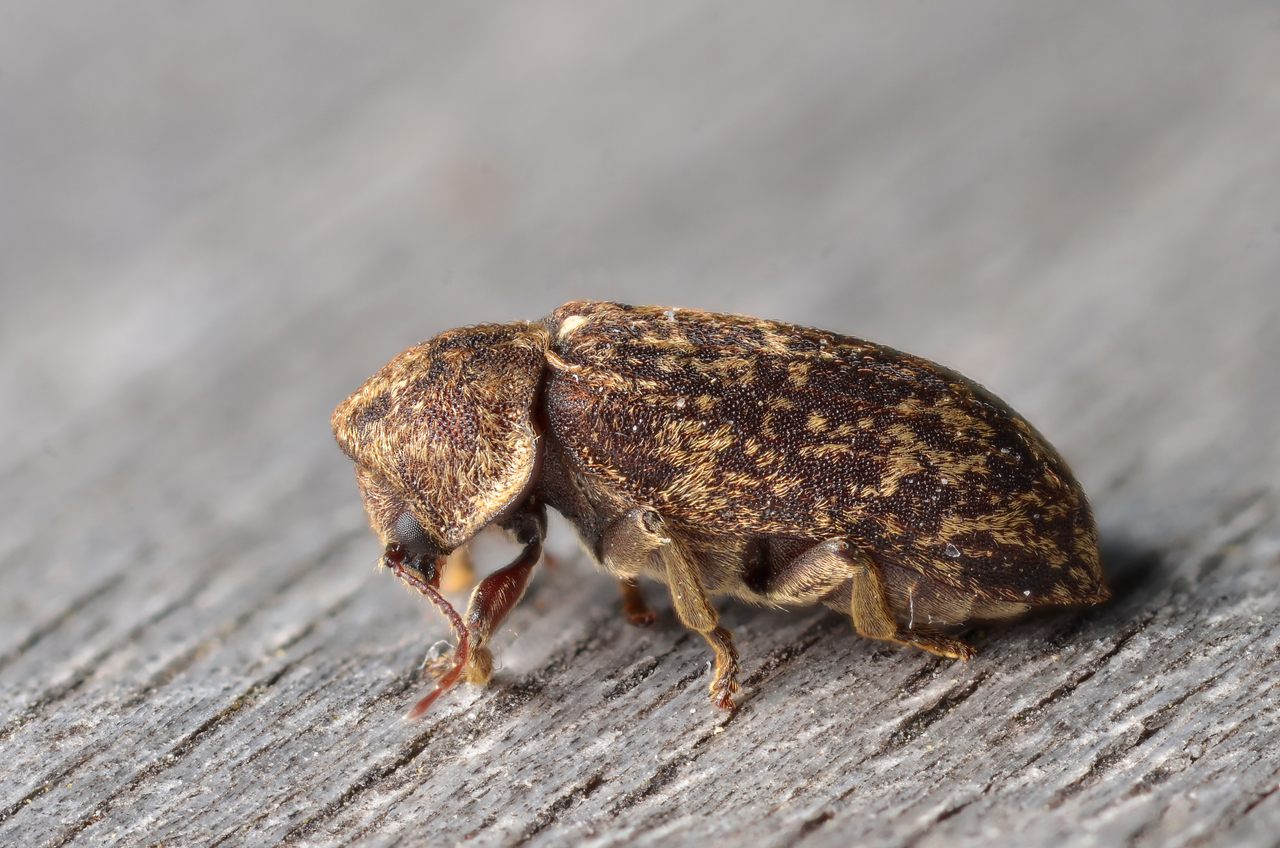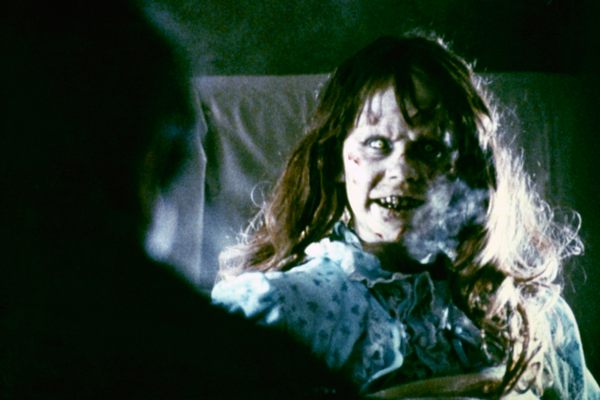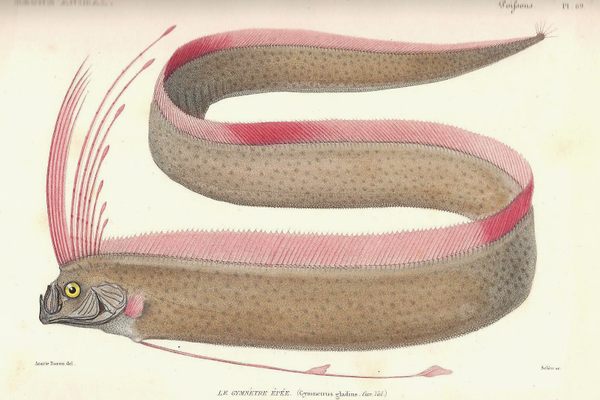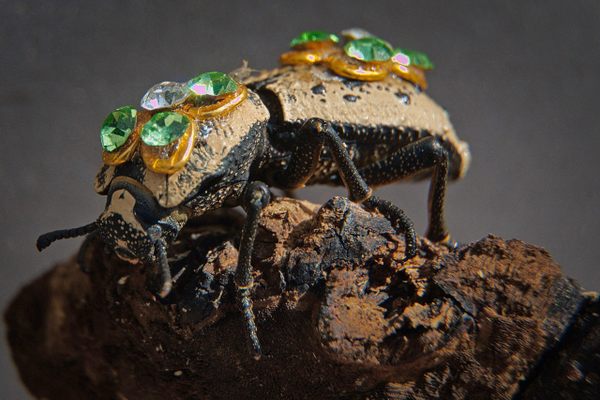The Truth Behind the Deathwatch Beetle’s Creepy Tap-Tap-Tapping
In the United Kingdom, the insects were once considered omens of death—they’re actually much more destructive.
The animal world is full of harbingers of doom—at least, according to superstitions. From the Tower of London’s ravens (whose departure would signal the fall of an entire nation) to the average black cat crossing your unlucky path, plenty of critters warn of woe. In Ominous Animals, we explore the lore—and the science—behind these finned, furry, and feathered messengers of impending calamity.
When a loved one fell ill in 17th-century England, a rhythmic tap, tap, tap echoing from the walls could set families on edge. Some likened the sound to the ticking of the Grim Reaper’s clock, signaling a death soon to come. The faster the tap-tap-tapping became, the closer death was. The real culprit was no harvester of souls, however. It was an insidious insect boring through the old oak walls: the aptly named deathwatch beetle, also known as death-watch.
“Few ears have escaped the noise of the death-watch, that is, the little clicking sound heard often in many rooms, somewhat resembling that of a watch,” naturalist Thomas Browne wrote in 1646. “And this is conceived to be of an evil omen or prediction of some person’s death.”
Odds are, if you were up late enough to hear it, you were already in a bad spot. “In the days before electricity, rural people would get up with the dawn and go to bed with dusk,” says entomologist Maxwell Barclay, collections manager of coleoptera (beetles) at the Natural History Museum in London. “There’d be no good reason to be awake at that time of night, so the only time they heard them was when somebody was sick.” These disturbing late-night sounds gave the beetle its grim name, but what those who heard the tap-tapping didn’t know was that the insects were focused on mating, not mortality.

The tapping is caused by deathwatch beetles ramming their heads against wood. Both males and females perform this mating call, filling wooden walls with typewriter-like clicking during their summer mating season. Males tap to attract females, and ladies knock to tell suitors where they are, says entomologist Joanie King at New Mexico State University. While there are a handful of “deathwatch” beetle species across the Northern Hemisphere, only one, the dull brown Xestobium rufovillosum, lives in the United Kingdom. In 1646, Browne attempted to quell fears about its legendary knack for divining death.
“He that could extinguish the terrifying apprehensions hereof, might prevent the passions of the heart, and many cold sweats in grandmothers and nurses, who in the sickness of children, are so startled with these noises,” Browne wrote. He captured deathwatch beetles and listened to them thwap themselves against the walls of the container—but no one died. Browne’s findings didn’t end the superstition, but it did diminish over time. Eventually, the beetles’ ominous reputation lived on only in literature.
Henry David Thoreau, Mark Twain, and Edgar Allen Poe all supposedly took inspiration from the beetle. “Next the ghastly ticking of a deathwatch in the wall at the bed’s head made Tom shudder—it meant that somebody’s days were numbered,” wrote Twain in The Adventures of Tom Sawyer.
As the superstition faded, the beetle gained a new notoriety. Throughout the UK, the aging oak beams of some of the country’s most cherished and iconic buildings made a particularly inviting—and delicious—home for these wood-boring insects. And there were consequences.
While the head-banging adult beetles only live for a month or two, in their larval stage they can survive for a decade. The hungry larvae’s favorite meal is old, preferably rotted wood, particularly oak. While their munching can carve out an extensive network of tunnels, destabilizing the wood, the damage is not obvious at first. Often, all that can be seen are exit holes smaller than the diameter of a pencil.

“So it looks fine from outside and then suddenly it collapses,” says Barclay. Entire roofs of old churches have failed as supporting beams, weakened by deathwatch larvae damage, gave way. Westminster Hall in London nearly succumbed in 1913 due to an infestation. The HMS Victory—the Royal Navy’s oldest ship still in commission—still battles the beetles today. “Today, I think if you said ‘deathwatch beetle,’ people would immediately think of big cathedrals falling down,” says Barclay.
The 20th-century poet John Heath Stubs even penned an ode to the beetles’ destructive nature: “Here come I, the death-watch beetle/Chewing away at the great cathedral.”
The beetles don’t stop at beams, either—they’ll happily eat anything made of old oak wood. Barclay recently found deathwatch damage on a 16th-century coffin; he suspects such signs of the insects’ presence may have fed the superstitions around them.

Despite those old associations with death—and the very real threat they pose to wooden buildings and artifacts—the beetles aren’t inherently bad, says entomologist King. In their natural environment, they can be found in the trunks of old oak trees, performing a crucial function for the ecosystem. “They are a pest when they’re in your home, but they do serve a purpose in their natural environments where they’re breaking down all this really old wood,” says King.
Understanding the science behind creepy creatures can also ground us, she adds. “Learning more about insects and other arthropods can help us be more aware of what’s going on around us,” she says. “When we understand something, we just have a better picture of the world.”


































Follow us on Twitter to get the latest on the world's hidden wonders.
Like us on Facebook to get the latest on the world's hidden wonders.
Follow us on Twitter Like us on Facebook